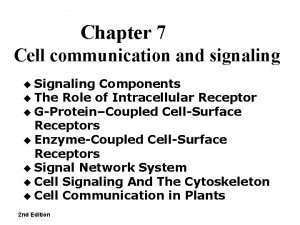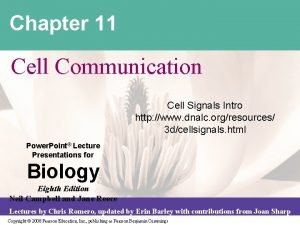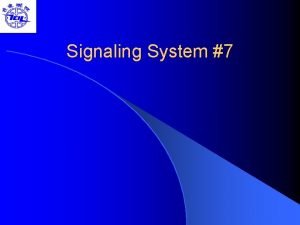Introduction to Signaling What is signaling Act of






![Why Control Networks? Service E[s(t)] B Voice Interactive Data Bulk Data Standard quality video Why Control Networks? Service E[s(t)] B Voice Interactive Data Bulk Data Standard quality video](https://slidetodoc.com/presentation_image_h2/874fb5df2c43c6b4a152adab5b689cc6/image-7.jpg)




- Slides: 11

Introduction to Signaling What is signaling? Act of transferring, in real time, service-related information between the users and the network elements, or between the network elements, to establish, maintain, and terminate end to end communications. Examples of signaling information in telephony - Desire for communications (off hook signal) - Ready for communications (dial tone) - Destination of communications (phone number) - Help request (dial 0) - Network unavailable (fast busy signal) - End user unavailable (slow busy signal) - Connection in progress (ringing) - Extended off hook (loud pulses)

Examples of Communications Service Telephone Integrated Services Digital Network (ISDN) Ethernet Frame Relay Fiber Distributed Data Interface (FDDI) Cable TV Internet Wireless Network

Channels Term Medium of communication over which information traverses. Popular medium types - Copper - Fiber - Air - Water Popular Channel Types - Twisted copper pair - Coaxial cable - Copper ribbon cable - RS 232 cable - IEEE 488 bus - Multi and single mode fibers - Cellular bandwidth (around 850 Mhz) - Personal Communications Service (PCS) bandwidth (around 2 Ghz)

Forms of signaling - Between user and network element at User-Network Interface (UNI) - Between network elements at Network-Node Interface (NNI) - Advanced–service signaling - Functions: service establishment, addressing, supervisory, alerting Signaling network: collection of physical facilities carrying the NNI signaling information. (E. g. , CCS 7)


Evolution of Telephone System Invention of Electromechanical Switches - Step-by-Step Switch by A. B Strowger in 1889 - No. 1 Crossbar Switch by AT&T in 1938 - No. 5 Crossbar Switch by AT&T in 1948 - Wired-Logic Control - Bottleneck in Switching Capacity Invention of Transistor in 1947 - High Speed Electronic Switches - Stored Program Control - Large Number of Subscribers - Bottleneck in Transport Capacity Optical Transport Technology - Fiber Bandwidth > 30 Tera hertz - Ultra High Rate Applications - Severe Bottleneck in Switching Capacity
![Why Control Networks Service Est B Voice Interactive Data Bulk Data Standard quality video Why Control Networks? Service E[s(t)] B Voice Interactive Data Bulk Data Standard quality video](https://slidetodoc.com/presentation_image_h2/874fb5df2c43c6b4a152adab5b689cc6/image-7.jpg)
Why Control Networks? Service E[s(t)] B Voice Interactive Data Bulk Data Standard quality video High definition TV (HDTV) High quality video telephony 32 kbit/s 1 -100 kbit/s 1 -10 Mbit/s 20 -30 Mbit/s 100 -150 Mbit/s ~2 Mbit/s 2 10 1 -10 2 -3 1 -2 5 Traffic Patterns Inter Arrival Interval

Signaling Methods Stimulus signaling - Insertion of current flow, interrupt of current flow, a sequence of tones, application of an AC voltage. - Only a limited amount of information can be conveyed this way. Functional signaling - Signaling information is transmitted in terms of defined data messages, called protocol. - Much more sophisticated information can be transmitted this way. - Suitable for machine initiated communication. Issues in Signaling Performance of signaling is critical to the performance of network. Correctness of signaling is difficult to achieve and verify. -Two army example.

Fundamental Issues in Today’s Networks Transmission rate >> Giga Bit/s Limitation in Speed of Electronic Processing Speed of Light Latency






















